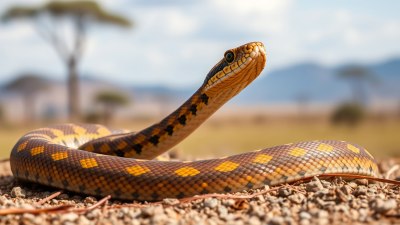Learning to Identify Local Venomous Snakes on Safaris
Master local venomous snake identification for safer safari experiences. Discover key tips and insights.

Image created with Flux Schnell
Embarking on a safari is one of the most exhilarating experiences one can have. The thrill of being close to wildlife in their natural habitat, alongside the picturesque landscapes, makes for unforgettable memories. However, with the beauty of nature also comes the potential risk of encountering venomous snakes. Learning to identify these creatures can enhance your safari experience and ensure your safety. This guide is designed to help you understand the various types of venomous snakes you may encounter during your adventure.
Why Knowledge of Venomous Snakes Matters
Venomous snakes play a crucial role in the ecosystems they inhabit. They help maintain the balance by controlling populations of rodents and other small animals. Unfortunately, snakebites can also pose serious risks to humans. Understanding the local snake species, their habitats, behaviors, and how to respond if you encounter one can not only keep you safe but also add depth to your safari experience. Knowledge empowers you to appreciate these fascinating reptiles while exercising caution.
Common Venomous Snakes in Africa
African countries have a rich diversity of snake species, many of which are venomous. Below are some of the common venomous snakes you may encounter while on safari:
- Black Mamba: Known as one of the deadliest snakes in Africa, the black mamba can be found in a variety of habitats, including savannas and forests. Characterized by its elongated body and a dark interior of its mouth, it can move exceptionally fast.
- Green Mamba: While less aggressive than its black counterpart, the green mamba is still venomous and often resides in trees, making it more elusive. Its vibrant green color helps it blend into its arboreal surroundings.
- Gaboon Viper: This large and powerful snake has one of the longest fangs of any snake species and is known for its striking patterns. It usually remains still and relies on camouflage, which can make it difficult to spot.
- Banded Krait: Although not as aggressive as some other snakes, the banded krait is notable for its potent venom. It is usually found near water bodies and can often be spotted during nighttime.
- Puff Adder: Common throughout much of Africa, the puff adder is responsible for a significant number of snakebites. It is recognized for its stocky body and a distinctive pattern that allows it to blend into its surroundings.
Identifying Venomous Snakes
When on safari, especially if you're in areas known for venomous snakes, it’s essential to know how to identify them, both for safety and educational purposes. Here are some tips to help you differentiate venomous snakes from non-venomous ones:
- Head Shape: Many venomous snakes have a triangular-shaped head, which is wider than their neck. This is especially true for pit vipers.
- Pupil Shape: Venomous snakes often have elliptical pupils, while non-venomous species tend to have round pupils. However, there are exceptions to this rule.
- Fang Structure: If you manage to see a snake's fangs (typically when it is threatened), venomous snakes usually possess longer and more pronounced fangs.
- Coloration and Patterns: Many snakes exhibit bright colors or distinctive patterns as a warning to predators. However, always remember that patterns can vary significantly across species and individuals.
- Behavior: Be aware of the typical behavior of the snakes in the area. For instance, some snakes may be more aggressive or likely to stand their ground when threatened.
Precautions When Exploring Snake Habitats
Taking precautions while in snake habitats is vital. Here are some useful tips to minimize the risk of snake encounters:
- Wear Appropriate Footwear: Sturdy, high-topped boots can help protect your feet and ankles from snake bites when walking through tall grass or rocky terrain.
- Stick to Designated Paths: Whenever possible, stay on established trails and avoid walking through underbrush where snakes are likely to be hiding.
- Be Aware of Your Surroundings: Always pay attention to your environment while walking or trekking. Look for movement, and listen for unusual sounds that may indicate the presence of snakes.
- Travel in Groups: It’s always safer to explore areas known for snakes in groups, as there’s safety in numbers and someone can seek help if needed.
- Educate Yourself: Before embarking on your safari, do some research on the species present in the area you will visit. Familiarizing yourself with snake types and their habitats can greatly help in identification.
What to Do If You Encounter a Snake
Should you come across a snake during your safari, here’s what you should do:
- Stay Calm: Panic can lead to hasty decisions. Try to remain still and assess the situation calmly.
- Back Away Slowly: If you spot the snake and it hasn’t reacted aggressively, slowly and quietly back away from its path. Most snakes prefer to avoid humans and will retreat if given the chance.
- Do Not Try to Catch or Harass the Snake: Even if it appears non-aggressive, it's best to leave snakes alone. Trying to catch or provoke a snake can lead to bites.
- Alert Your Group: If you’re on a guided tour, inform your guide as soon as you encounter a snake. They can then take the appropriate measures.
- Know First Aid for Snake Bites: Familiarize yourself with first-aid techniques in case of a snakebite, including how to apply a bandage and when to seek medical attention.
Identifying and understanding local venomous snakes during your safari is integral to ensuring a safe and enjoyable experience. By educating yourself about the types of snakes you may encounter, practicing caution in snake habitable areas, and knowing how to react in the event of an encounter or snakebite, you can appreciate the remarkable biodiversity Africa offers while minimizing risks. Colombia to Kenya and Tanzania to Zambia, each destination provides unique opportunities to observe wildlife, including these fascinating reptiles. Remember, a well-prepared traveler is a safe traveler, and gaining knowledge about venomous snakes is a crucial component of that preparation. Your adventure awaits—embrace the wild with respect and awareness!











